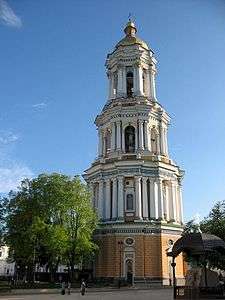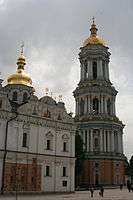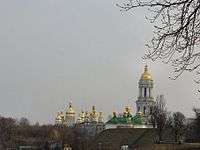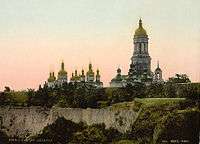Great Lavra Bell Tower
Coordinates: 50°26′05″N 30°33′23″E / 50.434691°N 30.556455°E

The Great Lavra Bell Tower or the Great Belfry (Ukrainian: Велика Лаврська дзвіниця, Russian: Большая Лаврская колокольня) is the main bell tower of the ancient cave monastery of Kiev Pechersk Lavra in Kiev, the capital of Ukraine. It is one of the most notable buildings of the Kiev skyline (see picture).
The bell tower was the highest free-standing bell tower at the time of its construction in 1731–1745.[1] It was designed by the architect Johann Gottfried Schädel. Its total height, with the Christian cross, is 96.5 metres (316 feet).
The Great Lavra Bell Tower is a Classical style construction with a total of four tiers, surmounted by a gilded dome. The diameter of the tower's lowest tier at its base is 28.8 metres (94 feet), and the thickness of the first tier walls is 8 metres (26 feet). The tower's foundation exceeds 7 metres (22 feet). The tower is decorated with many architectural columns: the second tier is decorated with 32 Dorian columns, the third tier is decorated with 16 Ionic columns, and the fourth with 8 Corinthian columns.[1][2]
On the third tier, there were some hanging bells, but they were later removed. To this day, only three small 18th-century bells have been preserved: the Balyk, Voznesenskyi, and Bezymiannyi bells.[2] The former main bell of the Great Lavra Bell Tower, the Uspenskyi, had a total weight of one ton and was cast in 1732 by Ivan Motorin, who was also responsible for the Moscow Kremlin Tsar Bell.[2] There is also a viewing platform atop the third tier, which provides visitors with a bird's-eye view of the region around Kiev.
On the fourth tier there is a chiming clock, manufactured in 1903, which has a total weight of 4.5 tons. The current bell tower's clock, designed by the Moscow master A. Enodin and based on the Kremlin clock, replaced the older 18th-century clock of the master A. Levynskyi.[2] The clock has stopped only once during its existence: it happened in September 1941 when the Dormition Cathedral of the Pechersk Lavra was blown up by army forces,[3] during the Second World War.
The clock was repaired following the destruction of the nearby cathedral, which took a total of six years to complete.[4] Since that time, the clock has never needed any repairs. The clock's mechanism is very accurate; up to within 10 seconds.[4] However, it has been observed that its accuracy depends on the time of the year: in the Winter, the clock works somewhat slower than in the Summertime. The clock's mechanism has to be rewound once a week, and the clock's bells chime every quarter of the hour.
Gallery
See also
- List of tallest Orthodox churches
- Assumption Cathedral, Kharkiv - the second tallest bell tower in Ukraine
Footnotes
| Wikimedia Commons has media related to Kiev Pechersk Lavra. |
- 1 2 Malikenaite, Ruta (2003). Guidebook: Touring Kyiv. Kiev: Baltija Dryk. ISBN 966-96041-3-3.
- 1 2 3 4 Klymenko, Sergiy. Велика дзвіниця Києво-Печерської Лаври. Pictures of Kyiv (in Ukrainian and Russian). Retrieved 2006-11-10.
- ↑ The cathedral was apparently mined for destruction by retreating Soviet troops, as was the Khreschatyk street in Kiev, and was apparently blown up by Nazi German forces. However, this is very controversial subject: the Germans blame the Soviets for the destruction of the cathedral and vice versa.
- 1 2 "Kiev's largest clock". Interesniy Kiev (in Russian). Retrieved 2006-11-11.
References
- Велика Дзвіниця. Wiki-Encyclopedia Kiev (in Ukrainian). Retrieved 2006-11-10.
- "Куранти Великої Дзвiницi". Wiki-Encyclopedia Kiev (in Ukrainian). Retrieved 2006-11-10.





